Photos with this report (click to enlarge) | |||
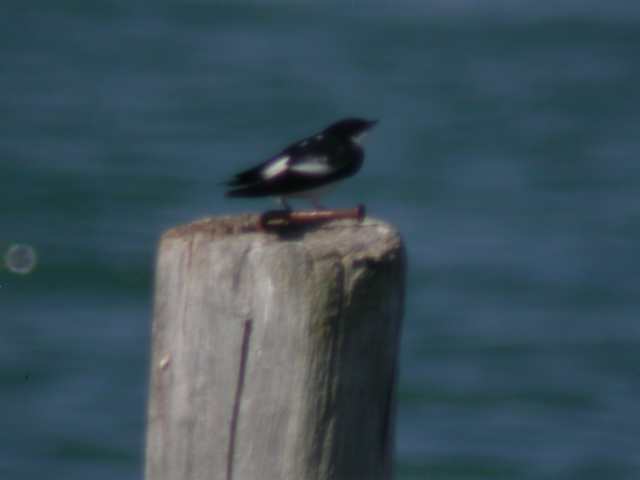 White-winged Swallow |
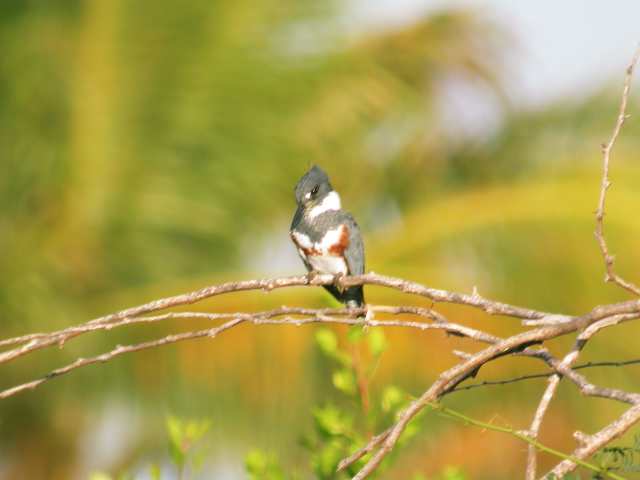 Belted Kingfisher female |
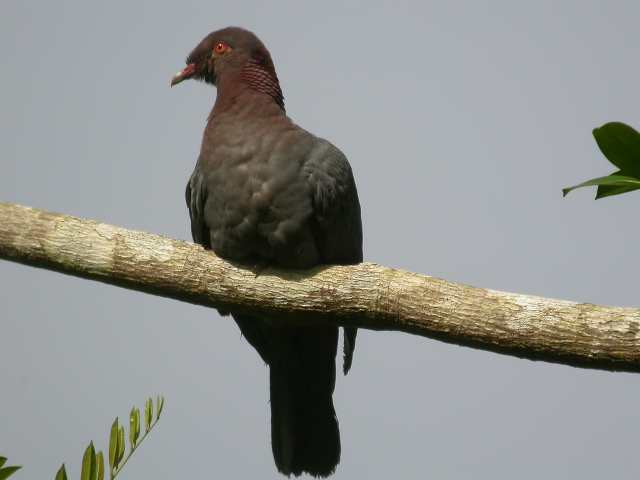 Scaly-naped Pigeon |
|
 Bananaquit black morph |
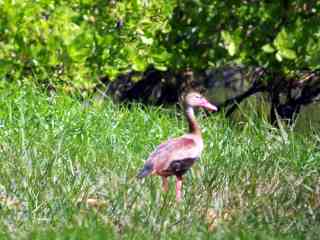 Black-bellied Whistling-Duck |
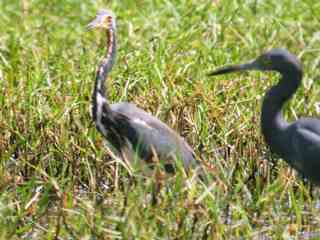 Tri-coloured Heron |
|
This was meant to be a holiday in the hot sun with a little birding, mainly in the mornings and around my hotel. However, after the first day, it became apparent that much more time would be needed for any other birding, because of the slowness of travelling on the roads. Many of these were either under repair or in a bad state, although much of the network was fine. There were diversions on both east and west coast main routes, avoiding bridges damaged by the two recent hurricanes.
Ivan hit the whole island in September 2004, with little warning and catastrophic effects; 85% of the buildings suffered. Emily struck in July 2005, with major damage to the north of the island. The tourist infrastructure has been largely restored, although the results of the storms are visible in many collapsed buildings, razed trees and scoured hillsides. The green undergrowth has already sprung up again- typical for the tropics- and there is much rebuilding.
I stayed at the Rex Grenadian; a two-minute transfer from the airport. (There are few flights and negligible noise disturbance.)
It has extensive, well-manicured grounds, with many trees and shrubs, three contiguous lakes, beach and is surrounded by thicker undergrowth, well worth investigating. Some people would be quite content to do all or most of their birding on foot in and around the hotel grounds:
The spacious, air-conditioned rooms are housed in blocks of several storeys and have satellite TV and views of, variously, the sea, lakes and/or grounds. The main restaurant has very good, buffet-style food, both traditionally British and more creative. There is also an oriental restaurant, which I did not visit. Staff, like most people on the island, are friendly and helpful. If I were to return, which is my aim, I would definitely stay here again, but also spend a few days based in the north- because of the roads!
I saw 34 species at the Rex, including fabulous views of male Hook-billed Kite (critically endangered Red List) on the first morning. A late afternoon arrival allowed half an hour before dusk to check the egret roost on the central lake: c90 Cattle Egrets, Great & Little Blue Herons, Great White Egret and Yellow-crowned Night-Herons. 4 Spotted Sandpipers and Tropical Mockingbirds completed a nice little starter list.
The next morning, I met the only local guide, Anthony Jeremiah (‘Jerry’) at 0600 hours. We spent the first hour around the grounds. Brown Boobies fished off the beach and the occasional Magnificent Frigatebird drifted in and out of view. Merlin and Peregrine flew through and Little Green Heron was added to the ‘egret’ list. Then Jerry located another raptor perched in a tree some way off; he became a little agitated and asked me to ‘scope’ it. Before I was able to do this, the bird was disturbed and flew straight towards us over our heads, perching in some trees quite close by. Over the next 10 minutes, we had stunning views of ‘the’ Kite, although a pesky mockingbird (not a species) prevented digiscoping with its constant harassment. Apparently, the usual views are in flight and at some distance: Jerry was both ecstatic and devastated that I had been unable to photograph the bird. Soon after, we saw a Broad-winged Hawk- which made a good and timely comparison! Some common local species, but new to me, were followed by my discovery of 2 Wilson’s Snipe on a small marshy area by the hotel security post. Jerry was sceptical when I said “Snipe!”- until he saw them.
We then drove a couple of miles to the protected dry forest reserve at Mt Hartman. The target bird here, Grenada Dove, is in even greater danger following Hurricane Ivan.
We only managed to hear one calling, some way away and unapproachable. However, close Mangrove Cuckoo, Grenada Flycatcher and displaying Blue-Black Grassquit were some compensation.
Our final destination was La Sagesse, a beautiful bay with mangroves and lagoon. This was some 30 minutes’ drive from the Rex, a few miles off the main road up the east coast. By the access road, we had Lesser Antillean Tanager (rather smart) and the local Bullfinch (similar). Parking by the hotel/restaurant, we walked south along the beach to view the lagoon, where there were Moorhens (whose frontal shields seemed somehow brighter than ours), Caribbean Coots and a Pied-billed Grebe. Almost at the ‘end’ of the beach were a few Ruddy Turnstones and Spotted Sandpipers and a Semi-palmated Plover. A short, muddy track led through the mangroves to another bay and beach. A little way along this, after pushing through the undergrowth, we were able to view the lagoon from the other end.
A flock of 38 Blue-winged Teal graced the waters- British birders will understand the verb. Thinking ‘this is a good place for a kingfisher’, I scanned the lake’s edges and was rewarded with a male Belted. Jerry did not at first believe me, as he had never seen one. He was, once again, well pleased.
This, sadly, terminated our time together, as he had to prepare for his own trip to Europe the next day. I can wholeheartedly recommend him and would have had no hesitation in utilising his services on several more occasions around the island- he is ideal for both the beginning and the more experienced birder.
The next day, I decided to spend around the Rex, with a little shopping in the (very) hot afternoon- having already had my hire car delivered to the hotel (4x4, expensive at over £250 for the week). I added Sora and Lesser Yellowlegs to my hotel list, with fly-over Caribbean Martin and (local race ridgwayi) Osprey. On the half-hour drive into the capital, I stopped at the harbour to scan the roosting Royal Terns. Momentary disbelief was immediately followed by intense joy by the sight of a White-winged Swallow on a post. Although this was not on the Avibase Grenada list, I’d considered it a possibility. Much frustration that I didn’t have my ‘scope. Luckily, I was able to rectify this later in the week.
Back at the hotel, towards dusk, I found a female Belted Kingfisher around the lakes.
Wednesday 21st saw me heading off early to the centre of the island. An hour later, I was at the Grand Etang and starting the Shoreline Trail.
This was supposed to take half an hour; in fact, it took me the best part of two hours. It was not difficult, but very muddy and reminiscent of other tropical ‘wet’ forests. Disappointingly few species were in evidence, even though I crept around- although I had good views of Scaly-naped Pigeon, an infrequently photographed species.
There are other trails, but having had a flu-type virus the week before, I was not up to the 3-hour mountain trek up to the summit of Mt Qua Qua.
I then headed off to Telescope, just east of Grenville. A dead-end track found me overlooking an extensive marsh with a small lake. Here there were several Tricoloured Herons- another species not on the Grenada list!
A duck, partly in the sun, puzzled me for a while. It was only after perusing the photos I took that I realised it was a Black-bellied Whistling-Duck- another rarity for Grenada.
My first Antillean Crested Hummingbird preceded a Greater Yellowlegs so close that I had to wait for it to move away to digiscope.
This area would benefit from much more observation.
It was then so hot that birding had become intensely uncomfortable, so I drove to the north coast, where I had planned lunch. Off the beach at Sauteurs were Brown Pelicans. . . and a white-tailed brown morph Red-footed Booby- another rarity for the island. (I was to see many more of these, albeit distantly, off Levera beach the next day, together with tropicbird sp.) A few miles west of Sauteurs is Almost Paradise, a superb restaurant with chalets (which is where I would stay), perched on top of Laurant Point. An idyllic setting, with Magnificent Frigatebirds drifting over. A White Pelican sp. went past too fast to properly identify: by the time I had dropped my cutlery and picked up my bins, it had almost gone. Another ‘first’ for Grenada.
The next day, I did the two-hour drive to the Levera Pond. Views from flight at 1000m (the next day) and north over Sugar Loaf Island to Carriacou.
Access is easy from the south; very difficult, if not impossible, from the north and west. This famous area was badly damaged by both hurricanes, but the threatened golf-course development was not in evidence. The visitor centre was closed for refurbishment. Despite much searching, I added nothing to my trip-list. An overflight the next day revealed more areas I could have investigated. As for Scarlet Ibis, which are said by park rangers to roost here ‘sometimes’ they, in fact, seem not to have been recorded for 50 years!
My drive back down the west coast took in Palmiste Lake- there were plantations and lush vegetation here.
This is accessed by a track behind the southernmost industrial buildings on Palmiste Bay. It is impossible without a four-wheel drive vehicle. An atmospheric location but, again, disappointing for numbers of birds. The higlight was a far-too-fast fly-past male Ruddy Quail-Dove.
The next day, I gave myself over to Sunsation Tours. This involved a short flight to Union Island, followed by several hours on the schooner used in the film ‘Pirates of the Caribbean’. We were to visit three islands in the Grenadines, which belong to St Vincent. Whilst everyone else either sunbathed or snorkelled, I birded the lagoon on Palm Island. This yielded c45 Ruddy Turnstones and a Spotted Sandpiper. Zenaida Doves were very tame here.
The lagoon on Mayreau was much more productive, with Lesser and 2 Greater Yellowlegs, Wilson’s Plover, 4 Spotted and 3 Stilt Sandpipers. There were other waders at the far side, but I had been advised not to bring my telescope (we had to jump in and out of the tender into the sea to make the beach) and did not have enough time to walk around. This place would certainly repay more investigation than the one hour allowed here.
An Osprey (race carolinensis) flew between the Tobago Cays and Union Island on the way back, and the reef off Union Island harbour held Grey Plover, Red Knot, Forster’s and Royal Terns. An interesting, if expensive (£160) day.
What was not meant to be my final day’s birding saw me return to La Sagesse, where I was to lunch at the well-known restaurant. Another migratory Osprey, Lesser Yellowlegs and now c60 Blue-winged Teal were on the lagoon. On the way back from the south end, slowly stalking butterflies, with camera and zoom lens at the ready, I heard what sounded like a Grey Wagtail. Immediately, I noticed a bird perched low on a stem along the path, in the shade. It was a waterthrush. Breaking my rule and instead of looking at it properly, I took some pictures. As I got my bins on to it, it flew. Despite much searching, it was not seen again. Consultation with experts has identified it as Northern- my first waterthrush!
Another visit to St George’s harbour paid off with the return of the Swallow (hence the photos) and my last new species for the trip- Laughing Gull.
Christmas Eve and coming down with a fever! Christmas Day, even worse with other symptoms and pouring with rain most of the day. Unable to eat, I managed to drive to the harbour to see the Swallow for the last time. No more birding. The airport transfer was early evening and I was able to procure a whole row of four seats for the 9 hour flight home- on which I lay prone for almost the whole journey. The fever has now gone - the memories will take much longer to fade. (The photos help.)
Information:
The Skyviews map is perfectly adequate for driving around the island. However, for birding off piste, I seriously recommend the 1:25,000 Grenada North (South is out-of-print) available from Stanford’s. Without it, I would not have thought of investigating the Telescope area or probably even have found the track to Palmiste Lake. A four-wheel drive is essential for some areas. Most of the hotels are in the south; there are three places in the north on the online map below.
Rex Grenadian email: grenrex@caribsurf.com
Rex website: www.rexresorts.com/_caribbean/_grenada/_grenadian/index.html
Almost Paradise: www.almost-paradise-grenada.com
Anthony Jeremiah email: tonydove200@yahoo.com - website: www.Guidedbirding.com
Car hire: www.skyviews.com/grenada/carhire.html
Tourist info: www.grenadagrenadines.com/index2.html
Online road map: www.skyviews.com/grenada/grenadamap.html (hard copy freely distributed by hotels, car hire companies, etc)
Stanford’s, London: www.stanfords.co.uk
Scaramouche schooner: www.grenadasunsation.com
Pied-billed Grebe Podilymbus podiceps Singles on La Sagesse lagoon and at Telescope
Tropicbird sp Phaeton sp Many far offshore from Levera beach
WHITE PELICAN sp Pelecanus sp One flew past Laurant Point too quickly to specify
Brown Pelican Pelecanus occidentalis Common along west and north coasts
Red-footed Booby Sula sula One close inshore off Sauteurs; many out to sea off Levera beach
Brown Booby Sula leucogaster Common offshore
Magnificent Frigatebird Fregata magnificens Singles offshore and occasionally over land in several places
Great Blue Heron Ardea herodias Widespread in small numbers
Great Egret Ardea alba Widespread in small numbers
Little Blue Heron Egretta caerulea Widespread in small numbers
TRICOLOURED HERON Egretta tricolor Several on marsh at Telescope
Snowy Egret Egretta thula One at Rex on 19th
Cattle Egret Bubulcus ibis Widespread in small numbers; up to 90 in roost at Rex
Green Heron Butorides virescens Widespread in small numbers
Yellow-crowned Night-Heron Nyctanassa violacea Up to 4 at Rex; nest-building activities noted
Black-bellied Whistling-Duck Dendrocygna autumnalis One on marsh at Telescope on 21st
Blue-winged Teal Anas discors c60 on La Sagesse lagoon
Osprey Pandion haliaetus Singles of both races in several coastal places
Hook-billed Kite Chondrohierax uncinatus Male seen well at Rex on 19th
Broad-winged Hawk Buteo platypterus Widespread
Merlin Falco columbarius Seen in several places
Peregrine Falcon Falco peregrinus Seen in several places
Sora Porzana carolina One at Rex on marshy area behind security post
Common Moorhen Gallinula chloropus Common on most marshy areas
Caribbean Coot Fulica caribea Several only on lagoon at La Sagesse
Black-bellied Plover Pluvialis squatarola One on reef off Union Island 23rd
Semipalmated Plover Charadrius semipalmatus Several on beach at La Sagesse
Wilson’s Plover Charadrius wilsonia One on lagoon at Mayreau Island 23rd
Wilson’s Snipe Gallinago delicata 3 at Rex; several elsewhere
Whimbrel Numenius phaeopus One on lagoon at Mayreau Island 23rd
Greater Yellowlegs Tringa melanoleuca One at Telescope 21st; 2 on lagoon at Mayreau Island 23rd
Lesser Yellowlegs Tringa flavipes Singles at Rex & La Sagesse; One on lagoon at Mayreau Island 23rd
Spotted Sandpiper Actitis macularia Small numbers in many wet areas
Ruddy Turnstone Arenaria interpres 4 on beach at La Sagesse; c45 on lagoon at Mayreau Island 23rd
Red Knot Calidris canutus One on reef off Union Island 23rd
Stilt Sandpiper Calidris himantopus 3 on lagoon at Mayreau Island 23rd
Laughing Gull Larus atricilla One in St George’s harbour 24th
Royal Tern Sterna maxima Widespread offshore; roost on posts in St George’s harbour
Rock Pigeon (introduced) Columba livia Present, unfortunately
Scaly-naped Pigeon Patagioenas squamosa Seen well at Grand Etang; in flight at several other places
Eared Dove Zenaida auriculata Common
Zenaida Dove Zenaida aurita Several locations; sustained close views at Mayreau Island
Common Ground-Dove Columbina passerina Common
GRENADA DOVE Leptotila wellsi Only heard at Mt Hartman
Ruddy Quail-Dove Geotrygon montana Male flew through at Palmiste Lake
Mangrove Cuckoo Coccyzus minor One at Mt Hartman
Smooth-billed Ani Crotophaga ani Widespread
Antillean Crested Hummingbird Orthorhyncus cristatus Seen in several locations
Belted Kingfisher Ceryle alcyon Male at La Sagesse lagoon 19th; female at Rex several days
GRENADA FLYCATCHER Myiarchus nugator Seen well in many places
Gray Kingbird Tyrannus dominicensis Common
Caribbean Martin Progne dominicensis Several in several places
Bank Swallow Riparia riparia On airport and over grassy area across road from Rex
Barn Swallow Hirundo rustica Widespread
WHITE-WINGED SWALLOW Tachycineta albiventer One St George’s harbour on posts by roosting Royal Terns 20-25th
House Wren Troglodytes aedon Widespread in small numbers
Tropical Mockingbird Mimus gilvus common
Bare-eyed Thrush Turdus nudigenis Singles seen at Rex and La Sagesse
Northern Waterthrush Seiurus noveboracensis On track by lagoon at La Sagesse
Bananaquit Coereba flaveola Common in both ‘yellow’ and black forms
Lesser Antillean Tanager Tangara cucullata One on access road to La Sagesse
Blue-black Grassquit Volatinia jacarina In display at Mt Hartman
Yellow-bellied Seedeater Sporophila nigricollis In several locations
Black-faced Grassquit Tiaris bicolor Common
Lesser Antillean Bullfinch Loxigilla noctis In several locations; seen well at La Sagesse
Carib Grackle Quiscalus lugubris Common
Shiny Cowbird Molothrus bonariensis Common